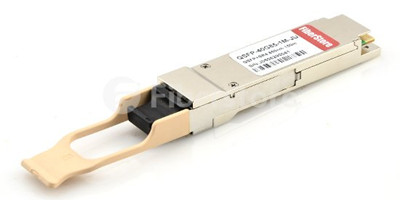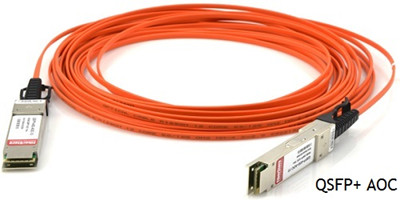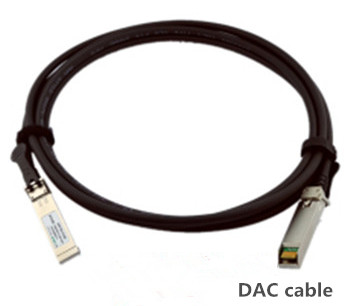40G Ethernet networking is the new trend for today’s big data age as 10G links cannot meet users’ needs for higher bandwidth. Telecommunication giants like Cisco, HP and Juniper are releasing relevant 40G optical devices to support this new technology. Of all the 40G optical options, 40G QSFP and QSFP cables are the most commonly utilized devices. Today’s article will make a brief introduction to 40GbE QSFP and QSFP cables.
40GbE QSFP Transceiver Modules
QSFP transceiver is a compact, hot-pluggable transceiver used for 40G data communications applications. QSFP interfaces networking hardware to a fiber optic cable. Compared with SFP modules, QSFP transceivers increase the port-density of 3-4 times and integrates 4 independent 10 gigabit per second data lanes in each direction to provide 40Gbps bandwidth. 40GbE QSFP transceiver is widely applied in Ethernet, Fibre Channel, InfiniBand and SONET/SDH standards with different data rate options. A variety of QSFP transceivers are available on the market, such as QSFP-40G-CSR4, QSFP-40G-PLR4, 40GBASE-PLRL4, QSFP-40G-SR4, QSFP-40G-LR4, etc. Take QSFP-40G-CSR4 (see in Figure 1) as an example, it is the compatible Cisco 40GBASE-CSR4 QSFP modules that extend the reach of the IEEE 40GBASE-SR4 interface to 300 and 400 meters on laser-optimized OM3 and OM4 multi-mode parallel fiber, respectively. It primarily enables high-bandwidth 40G optical links over 12-fiber parallel fiber terminated with MPO/MTP multifiber connectors.
QSFP transceiver is a compact, hot-pluggable transceiver used for 40G data communications applications. QSFP interfaces networking hardware to a fiber optic cable. Compared with SFP modules, QSFP transceivers increase the port-density of 3-4 times and integrates 4 independent 10 gigabit per second data lanes in each direction to provide 40Gbps bandwidth. 40GbE QSFP transceiver is widely applied in Ethernet, Fibre Channel, InfiniBand and SONET/SDH standards with different data rate options. A variety of QSFP transceivers are available on the market, such as QSFP-40G-CSR4, QSFP-40G-PLR4, 40GBASE-PLRL4, QSFP-40G-SR4, QSFP-40G-LR4, etc. Take QSFP-40G-CSR4 (see in Figure 1) as an example, it is the compatible Cisco 40GBASE-CSR4 QSFP modules that extend the reach of the IEEE 40GBASE-SR4 interface to 300 and 400 meters on laser-optimized OM3 and OM4 multi-mode parallel fiber, respectively. It primarily enables high-bandwidth 40G optical links over 12-fiber parallel fiber terminated with MPO/MTP multifiber connectors.

40G Cabling Options
40G cable is also known as QSFP cable. QSFP direct attach copper cable (DAC) and QSFP active optical cable (AOC) are the two common types of 40G cables on the market. Active optical cable provides a more flexible cabling than DAC cables with the advantages of lighter weight, longer transmission distance and higher performance. Recently 40G AOC assemblies are very popular among users.
40G cable is also known as QSFP cable. QSFP direct attach copper cable (DAC) and QSFP active optical cable (AOC) are the two common types of 40G cables on the market. Active optical cable provides a more flexible cabling than DAC cables with the advantages of lighter weight, longer transmission distance and higher performance. Recently 40G AOC assemblies are very popular among users.
QSFP+ AOC is a high performance integrated cable for short-range multi-lane data communication and interconnect applications. It integrates four data lanes in each direction with 40Gbps aggregate bandwidth. Each lane can operate at 10Gbps with lengths ranging from one to 100m. Fiberstore QSFP+AOC solution is designed for high-density applications. Usually they can be applied in following areas: InfiniBand QDR (4 x 10G), DDR (4 x 5G) and SDR (4 x 2.5G) interconnects, High Performance and High Productivity computer interconnects, Data Aggregation, Backplane and Proprietary Density Applications, PCI-Express, SAS/SATA, Fibre Channel compatible interconnect, Datacom and Telecom switch and router backplane connections. Figure 2 presents a QSFP+ AOC.

There are DAC cables (see in Figure 3) available for 40GbE optics when short distance (within the same rack) cabling runs are needed. Passive cables are available in the standard one, three, and five-meter lengths. Active cables are available for longer runs. QSFP+ passive copper cable is an extension of the established interface system SFP+ and was developed for 40Gb Ethernet and 40Gb/s Infiniband QDR applications. 40GbE passive copper cables provide robust connections for leading edge 40G systems filling the need for short, cost-effective connectivity in the data center. Passive copper cables require no additional power to ensure quality connectivity. The QSFP+ passive cable assemblies are high performance, cost effective solutions for 40G LAN, HPC and SAN applications.

Conclusion
2010 witnessed the ratification of the IEEE 802.3ba standard for 40G Ethernet. Deploying 40G data center will likely include using a combination of 40G modules and 40G cables. Thus choosing the right one for the right area of data center will have great effect in achieving reliable 40G speed. Fiberstore offers the 40GbE optical devices including 40G QSFP and 40G DAC cables with high performance and low prices.
2010 witnessed the ratification of the IEEE 802.3ba standard for 40G Ethernet. Deploying 40G data center will likely include using a combination of 40G modules and 40G cables. Thus choosing the right one for the right area of data center will have great effect in achieving reliable 40G speed. Fiberstore offers the 40GbE optical devices including 40G QSFP and 40G DAC cables with high performance and low prices.
评论
发表评论